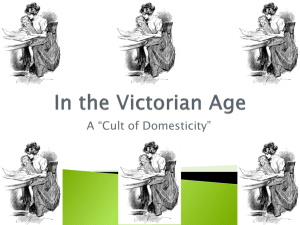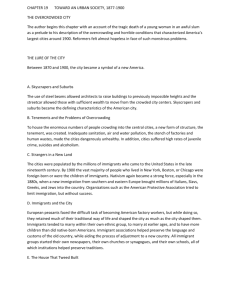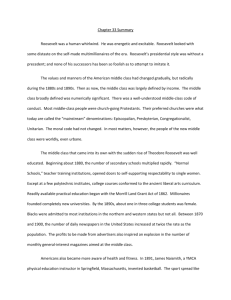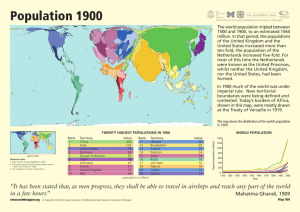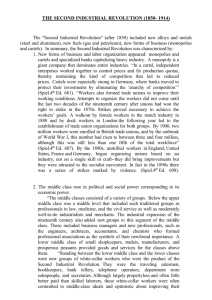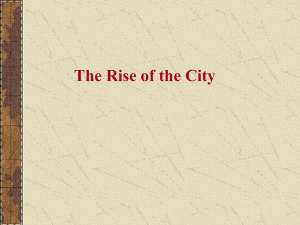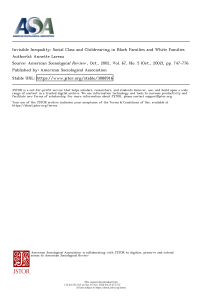Mass Society in an Age of Progress
advertisement
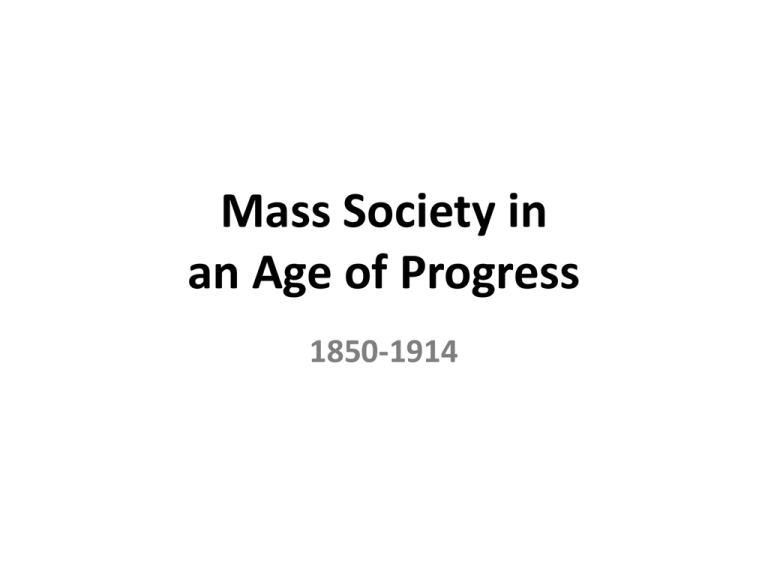
Mass Society in an Age of Progress 1850-1914 Second Industrial Revolution • Last ½ of 19th century • Four major aspects – – – – Steel production Oil Electricity Chemicals • Created growing demand for experts with specialized knowledge • By 1890’s Germany became most powerful industrial economy in Europe • Continued to attract huge numbers of workers to cities New Products & Inventions • Electricity – Light bulb: Thomas Edison – Telephone: Alexander Graham Bell 1876 – Gramophone: Edison 1877 – Motion Picture: Lumiere 1895 – Radio: Guglielmo Marconi 1901 • Internal Combustion Engine (Gottlieb Daimler ) – Mass production: Henry Ford – Zeppelin Airship 1900 – Wright Brothers 1903 Women’s Roles • “Right to work” • Ideal of domesticity • New job opportunities – Department store clerks, stenographers, secretaries, waitresses, nurses (white collar) – Domestic servants • By 1900 over ½ of working women were domestic servants • After 1850 the work of most wives was increasingly distinct & separate from their husbands – Husbands became primary wage earners – Wife dominated the home domain • Middle-class women began to organize & resist their 2nd class status to husbands Socialist Movements • Main Goal: advance the cause of the proletariat (working class) – Saw nationalism as a tool of the rulers – Opposed to war • Marxism led the negative response to industrialization – First International: 1864 – Growth after 1871 was phenomenal • Developed by Karl Marx & Industrialization & Friederich Engles the Marxist Response • The Communist Manifesto (1848) – Considered the “Bible” of Communism – The economic interpretation of history – Class struggle – Theory of Surplus Value – Socialism was inevitable – Violent revolution – “dictatorship of the proletariat” – Classless society Revisionism • As workers gained the right to vote & participate in gov’t, their attention focused more on elections that revolutions – Unions accepted & focused on bread-&-butter issues • Collective bargaining officially recognized as desirable by unions • Eduard Bernstein: Evolutionary Socialism (1899) Eduard Bernstein – Argued Marx’s predictions of ever-greater poverty for workers & ever-greater wealth in fewer hands had been proved false Impact of Socialism • Impact on politics became profound • Germany: Social Democratic Party (S.P.D.) – Marxist in philosophy – Bismarck forced to institute sweeping reforms to minimize threat from left – By 1912, the S.P.D. was the largest party in the Reichstag • France: socialists gained seats in Chamber of Deputies • England – Fabian Society – Independent Labor Party – Foundations for social welfare state created in decade prior to WWI – meant to guarantee each citizen a decent standard of living Anarchy • Spun off from the mainstream socialist movement • Sought to destroy the centralized state • Mikhail Bakunin – Russian nobleman, became the most influential anarchist • Strongest in Spain & Italy • Political assassinations by anarchists shook the political world between 1881 & 1901 – – – – Deaths of 6 national leaders Alexander II of Russia 1881 King Umberto I of Italy 1900 President William McKinley 1901 19th Century Society • Increased standard of living by the 2nd half of 19th century – Still huge gap between wealthy & working class – Became “golden age of the middle class” • Industrial & urban development made society more diverse & less unified • Diversity within middle class/bourgeoisie (15% of population) – Upper middle-class: bankers, ind. leaders, top gov’t officials – Diversified middle class: small businessmen, professionals, merchants, doctors, lawyers – Lower middle class (petite bourgeoisie): small merchants, shopkeepers, teachers, clerks, master craftsmen • Grew from 7% to 20% of population by 1900 • Women worked as store clerks, stenographers, secretaries, nurses Characteristics of the middle class • Emphasized individual liberty & respectability based on economic success • Families emphasized frugality & planning for the future • Gained political influence through increased landownership (tied to voting rights) • Saw family as the foundation of the social order • Education & religion were extremely important Working Class • 80 % of the population • Less unified & homogenous than middle classes • Highly skilled workers at the top (about 15% of population): “labor aristocracy” – Construction bosses, foremen, highly skilled craftsmen • Semi-skilled workers: carpentry, bricklaying, successful factory workers • Unskilled workers & domestic servants (mostly women) were at the bottom – By 1900 half of working women were domestic servants • Romantic love became the most important reason for marriage by Changing Family 1850 • Middle-class females were monitored extremely closely by parents – Chastity paramount – Middle-class boys not monitored nearly as much • High rate of illegitimacy decreased after 1850 – Rate of premarital sex the same, but more couples married if pregnancy occurred • Fidelity emphasized in middle class • Prostitution: middle & upper class men constituted most of the customers (married late) Child-rearing • Middle-Class – Lower mortality rates = parents becoming more emotionally involved in children’s lives – Married couples decreased the # of children they had – Increase in books published on child-rearing – Parents much more intent on improving the economic & social condition of their children • Working-class families Child-Rearing – Boys & girls went to work when they reached adolescence – Kids did not remain economically dependent on their families (unlike middleclass) – Young working-class adolescents broke away from the family more easily when emotional ties became oppresive – In 20th century, middle-class youths would follow this pattern • State’s role in education increased Education – Further secularization of society – Emphasized loyalty & service to the state – By 1900 in England, all children 5-12 years old were required to attend school (education was free) – In France, the Ferry Laws required children ages 3-13 to attend school (also free) • Significant increase in literacy – Men had higher rates of literacy – Urbanites more literate than rural – Higher literacy rate in northern & western Europe • Girls had less access to secondary education than boys – Education seen as a means of improving economic & marriage prospects for girls Increased Consumption • Increased leisure time & increased money to spend • Sports attracted spectators & participants – Sports clubs grew – Soccer, rugby, bicycle & automobile races, track & field – Huge bicycle craze swept Europe – Became organized with rules – Increased numbers of women took part • Women abandoned more restricted clothing – Sports culture mirrored the growth of aggressive nationalism • Social Darwinists believed that sports competition confirmed the superiority of certain racial groups More Leisure & Spending • Cafes & taverns • Department stores grew • Dance halls, concerts, & plays drew thousands of people each week • Amusement parks • Mass tourism – Thomas Cook Age of Mass Politics • The Paris Commune – Napoleon III’s Second Empire ends with defeat by Prussia (1870 Franco-Prussian War) – New National Assembly created – However, a radical communist gov’t (Paris Commune) took over Paris – From March-May 1871, the Paris Commune fought a bloody struggle with troops of the National Assembly & lost 3rd French Republic • Established in 1875 • Constitution provided for a republic – Chamber of Deputies had most power. – President was weak. • Reforms – Trade unions legalized – Established secular education (public schools & compulsory education) • Boulanger Crisis – – – – Georges Boulanger gained support of the military Plotted a coup The Republic summoned Boulanger to trial but he fled to Belgium & committed suicide Resulted in greater confidence in the Republic Eastern Europe: • Germany – Parliamentary gov’t Persistence of • Bicameral legislature established Old Order (Reichstag) – 1871 constitution – Emperor commands the military in Prussian tradition – Bismarck’s conservatism • Kulturkampf – Sought to limit the influence of the Catholic Party • Social Democratic Party (SPD) – Bismarck instituted sweeping reforms to minimize the threat from the socialists – Despite better standard of living, workers did not leave the SPD Russia • Alexander II – Possibly the greatest czar since Catherine the Great. – Believed serfdom had kept Russia from modernizing – 1861: Emancipation Act abolished serfdom – Assassinated in 1881 by anarchist radicals who bombed his carriage. • Alexander III – Most reactionary czar (undo reforms of Alexander II) – “Autocracy, Orthodoxy, Russification” – Anti-semitism
